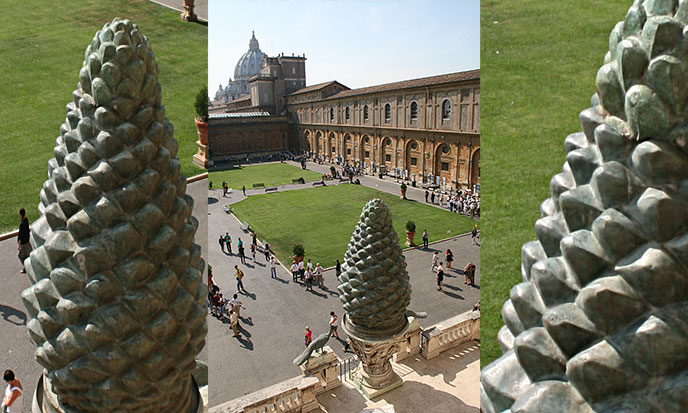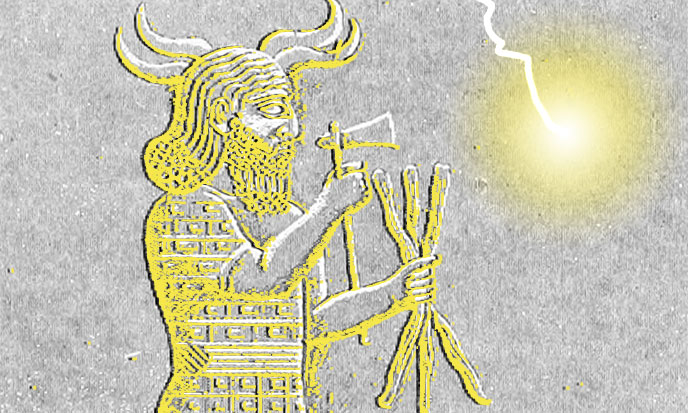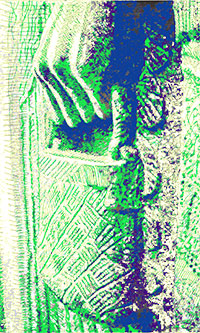
The human brain contains, among other diamonds, a small gland that works wonders: the epiphysis or pineal gland. Housed in the center of the brain, it is shaped like a pine cone, hence its name.
The pineal gland is located between the two hemispheres, at the upper end of the spinal cord which lower end is the sacrum, the sacred triangular bone from which kundalini springs at the awakening.
Current medical science knows little about the brain and the higher consciousness. It knows even less about the sacred role of the pineal gland. Tradition says that this gland is the embryo – or excess – of a third eye that can see what the other two do not show.
This third eye is named Wedjat in Egyptian. His plain name is the Eye of Horus.
The Cyclops – our very distant ancestors – had this third eye on forehead, with which they threw dazzling glare: humans could not even see the other two eyes of Cyclops, hence the legend of one-eyed giants.
Rays launched by this third eye was not only stunning: they had the power to heal or kill.
The pineal gland is called gland of awakening, here’s why. “The pineal gland is the first formed in the fetus, it is distinguished by the third week when the life force enters the fetus seven weeks she goes through the pineal gland and triggers the first primordial flood of DMT (N-dimethyltryptamine).” (source)
Later, trances or emotional shocks can cause what is called a rise of kundalini.
The powerful energy of awakening unfolds along the column and when reaching top it excites the epiphysis which produced more DMT: “DMT is the mediator of pivots experiences of deep meditation, shamanic states of consciousness, psychoses, spiritual emergence and near death experiences.” (source)

The composition and effects of the DMT approaches the THC or Tetrahydrocannabinol, the active ingredient in marijuana. Hence the nickname of DMT: facetious scientists have called anandamide, from Ananda, Hindu goddess of bliss.
So our pineal gland produces anandamide when excited, and it is excited when kundalini raises and reaches it.
Therefore the awakening state resembles a lot the effect of hemp, which is enough to condemn the ridiculous current prohibition.
Due to this prominent function of gland of awakening, the pineal gland very often appears in the Sumerian and Babylonian images.
 The Anunnaki gods are shown with situla – bucket of Water of Life – in one hand and a pine cone raised to eye level in the other hand.
The Anunnaki gods are shown with situla – bucket of Water of Life – in one hand and a pine cone raised to eye level in the other hand.
The situla is this curious purse handled by all gods before, regardless of their continent of origin. A bag so valuable that the gods will never separate, which poses a very exciting puzzle.
In my view, as I said, the situla contained the vital water, rejuvenating water or water of eternity, this precious jade water that all mythologies evoke under many names.
The former gods carry it in left hand, while in the right hand they brandish the pine cone / epiphysis.
This pine cone, as we have seen, is the pineal gland. It is often found as so-called decorative element in sacred architecture in churches, in mosques, in temples and synagogues, but also on some trendy TV shows, one wonders why. The decorative aspect is null and dull, there must be another reason, what do you think?
For me, the reason is simple: this little pine cone, this gland we have in head is the key to enlightenment, hence its symbol. Insiders have always used it for this purpose, as well as the eye of Horus.
For the sculptor, this was the best way to express the gods enlightenment, ie their divinity, ie their eternity.
If you like that kind of surprise, I recommend a good one, without to go to Vatican’s courtyard. Take a walk to the Louvre in Paris. The central courtyard, the one with the pyramid of Pei.
Let me lead you to the equestrian statue of Louis XIV. Speaking of lead, the statue is precisely made of lead. Lead is certainly not an usual metal to melt statues. Too soft. One must have an absolute necessity to melt this statue in lead. It is off the square, a little apart; it has its reason to be, and to be there and to be lead.
The reason ? Energetics. Just sit down on the base of the equestrian statue. You soon will grasp what I mean.


